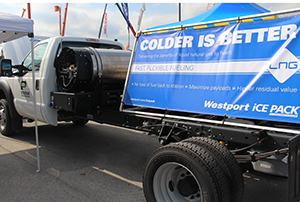
Fleet owners contributing to the natural gas extraction boom are increasingly looking to power their equipment on it. However, the alternative fuel's up-front cost and lack of infrastructure remain steep barriers to mainstream adoption.
Potelco, a utility firm in the Pacific Northwest and unit of Quanta Services, is experimenting with running medium-duty construction trucks on liquefied natural gas (LNG). Until now, LNG has appeared mainly on long-haul trucks operating in coastal states.
"It's half the price of diesel fuel, it's domestic and it's clean," said John Howell, senior director of marketing and business development for Westport, which exhibited a prototype LNG truck it developed for Potelco at the International Construction and Utility Equipment Exposition on Oct. 1 in Louisville, Ky.
Believed to be the first of its kind, a bi-fuel Ford F-550 Super Duty truck chassis provided the underpinnings for Potelco's concept truck on display at the ICUEE show. The unit was fitted with a hardened V-10 gasoline engine, LNG injector rails and Westport's new iCE PACK cryogenic tank. This particular chassis would likely be upfitted with a dump body, Howell noted.
Holding the equivalent of 60 gallons of gasoline and sitting behind the operator's cabin, the tank keeps the LNG fuel at a temperature of roughly 260 degrees below zero Fahrenheit and pressurized to about 300 psi. The truck also had a 40 gallon gasoline tank mounted below the frame rails and behind the rear axle.
The truck is calibrated to start on LNG and then switch seamlessly to gasoline once the gaseous tank is empty. An LNG fuel gauge on the cab's center stack helps drivers keep tabs on the alternative fuel supply.
Once the cryogenic tank is filled, which takes only a few minutes, the fuel needs to be used within 10 days, Howell said, or it will eventually dissipate as it warms up.
The LNG system effectively doubles the vehicle's range and costs about $25,000, adding roughly 63% onto the $40,000 base truck's price. But few of these trucks run bare: Utility bodies typically add thousands more to the cost of the truck, bringing down the LNG premium.
Although some construction firms have started to power trucks on compressed natural gas, few have asked for LNG, Howard said. One reason is the lack of fueling infrastructure: More than 600 public CNG stations are available across the U.S.; however, only 35 LNG stations exist today, according to the Dept. of Energy.

Post a comment to this article
Report Abusive Comment